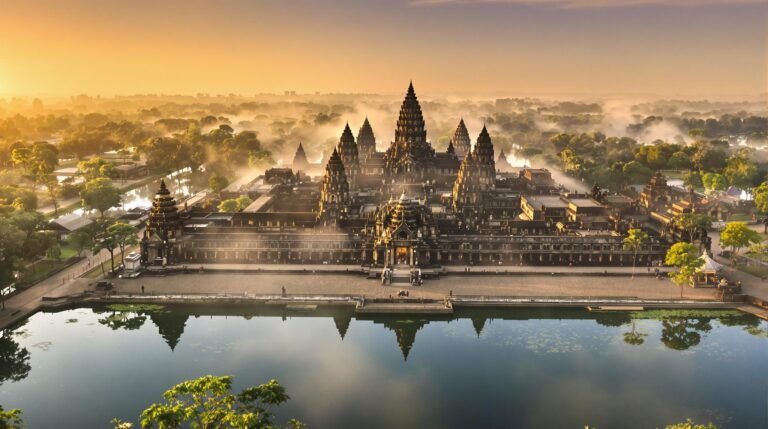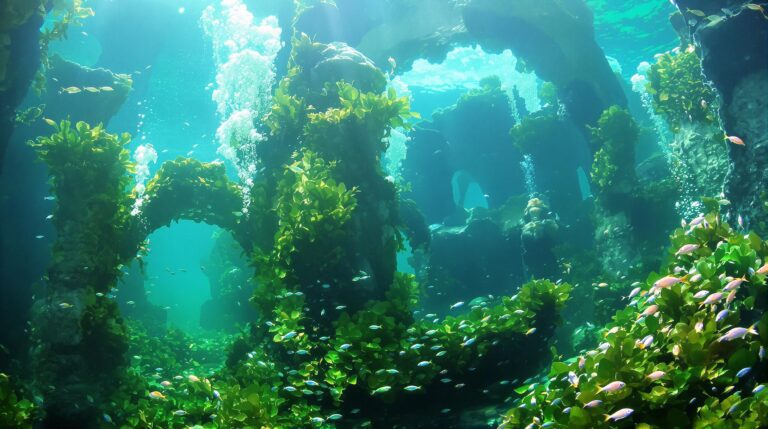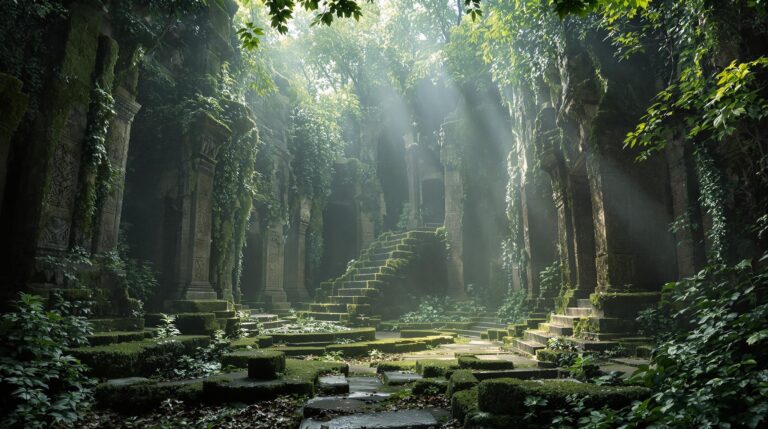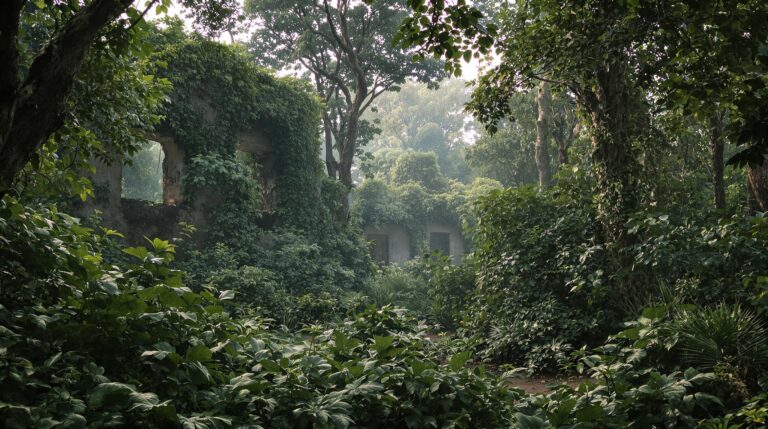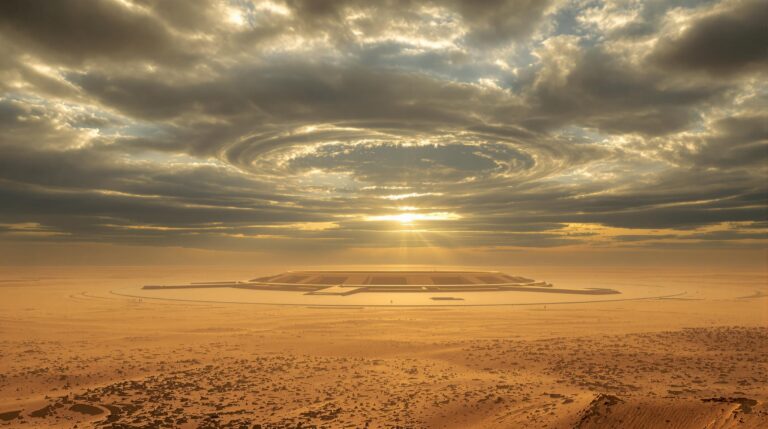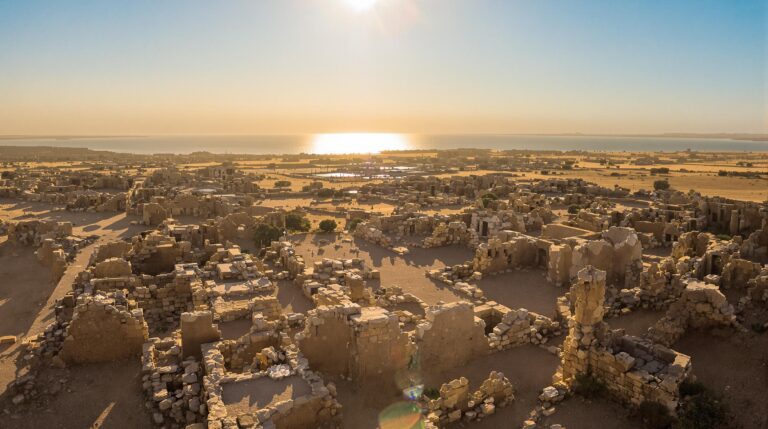Machu Picchu: The Lost Incan City
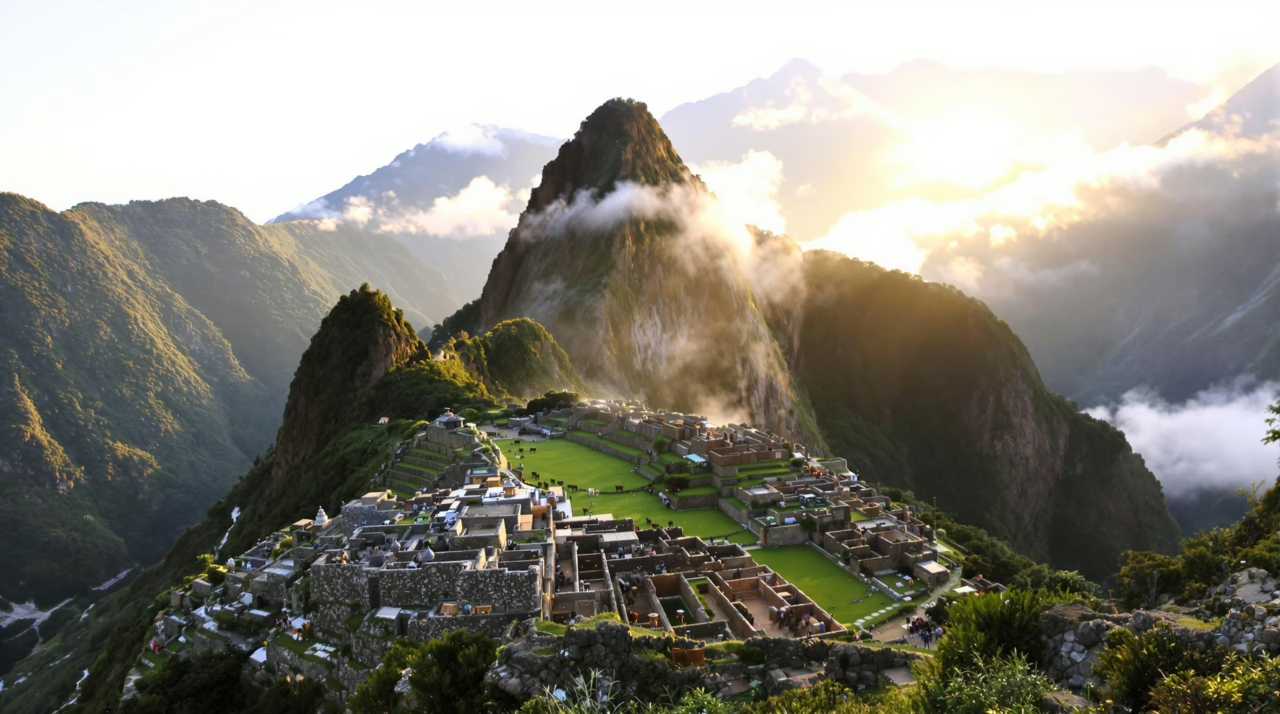
Machu Picchu stands as a remarkable tribute to Incan ingenuity and spirituality.
Its intricate stonework and terraced fields raise questions about the civilization’s agricultural practices and societal structure.
What motivated its builders to create such a monumental site high in the Andes?
The echoes of its past linger, inviting exploration of its profound symbolism and the mysteries surrounding its abandonment.
What secrets remain hidden within its ancient walls?
Highlights
Hide- Machu Picchu, discovered by Hiram Bingham in 1911, is often referred to as the Lost City of the Incas due to its isolation.
- The site features remarkable architecture, including temples and terraced fields, showcasing Incan engineering and sustainable agricultural practices.
- Theories about its purpose include serving as a royal estate, a religious sanctuary, or a military outpost for the Inca civilization.
- Machu Picchu's design aligns with celestial events, reflecting the Incan connection to the cosmos and their spiritual beliefs.
- Ongoing research utilizes modern technology to uncover new insights and preserve the site amidst challenges posed by tourism and natural erosion.
The Discovery of Machu Picchu That Changed History
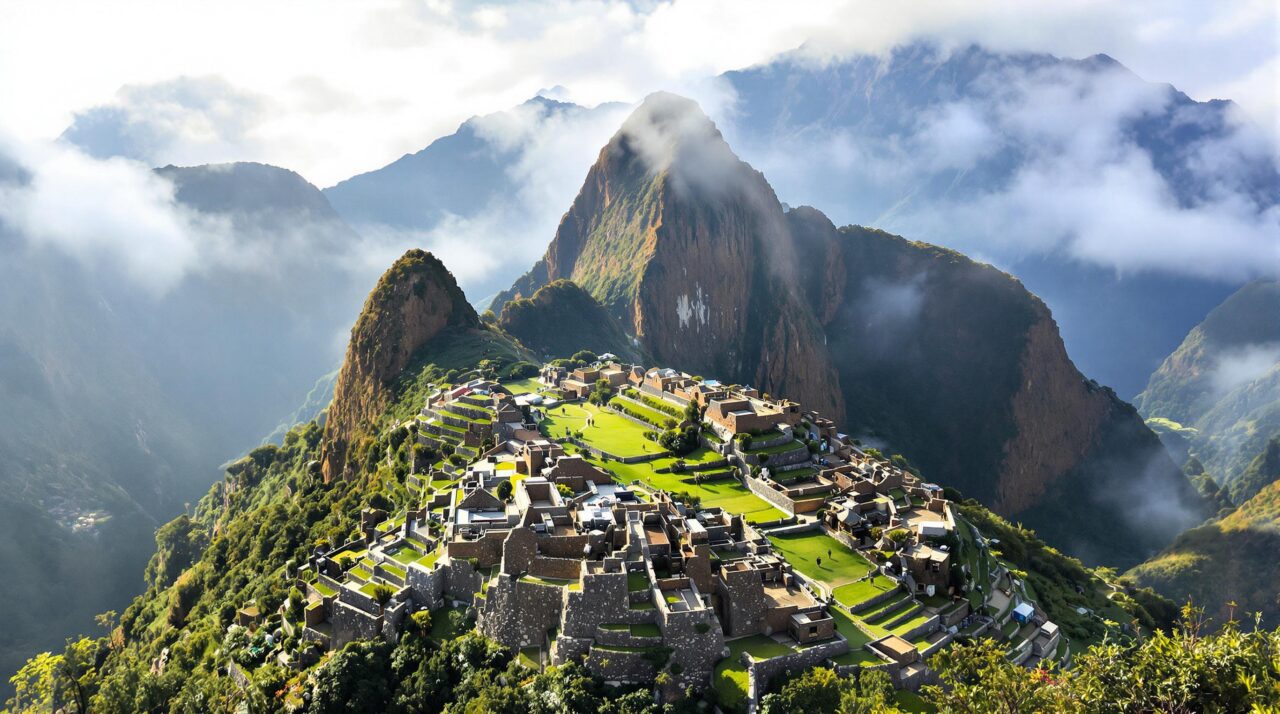
In 1911, Hiram Bingham’s expedition unearthed Machu Picchu, a site that would soon capture the world’s imagination and alter historical narratives about the Incan civilization.
What prompted such a fervent global reaction to this hidden gem, and how did it reshape perceptions of pre-Columbian cultures?
The implications of Bingham’s discovery extend far beyond the physical ruins, inviting a deeper inquiry into the legacy of the Incas and their enduring influence on contemporary society.
Hiram Bingham’s 1911 Expedition
Hiram Bingham, an American explorer with grand expectations, commenced his 1911 expedition to uncover the fabled Lost City of the Incas.
Yet, it was the local knowledge provided by Agustín Lizárraga that ultimately guided him to the hidden ruins of Machu Picchu, raising questions about the interplay between outsider ambition and indigenous insight.
How did this collaboration reshape the understanding of Incan history and cultural heritage?
Who Bingham Was and What He Expected
The figure of Hiram Bingham looms large in the annals of archaeological exploration, embodying both ambition and intrigue.
His expectations during the 1911 expedition were shaped by a desire for discovery and validation, driving his quest to Machu Picchu.
Bingham anticipated:
- Ancient treasures
- Lost Incan knowledge
- A historical breakthrough
- Personal fame
- An enduring legacy
His aspirations would ultimately reshape perceptions of the Incan civilization.
Local Knowledge and the Role of Agustín Lizárraga
Bingham’s expedition, while ambitious, was considerably bolstered by the local knowledge of Agustín Lizárraga, a farmer who played a pivotal role in guiding the American explorer to the hidden site.
Lizárraga’s intimate understanding of the land and its secrets not only illuminated the path to Machu Picchu but also underscored the importance of local wisdom in uncovering historical treasures long shrouded in mystery.
Early Global Reactions to the Site
The discovery of Machu Picchu ignited a wave of global intrigue, capturing the imagination of both scholars and the public alike.
How did the media portray this ancient marvel, and what scholarly debates were sparked by its revelation?
As the world was introduced to the Lost City of the Incas, questions arose about its significance and the narratives surrounding its existence.
Media Attention and Academic Excitement
Amidst the breathtaking peaks of the Andes, the revelation of Machu Picchu in the early 20th century sparked a fervent wave of media attention and academic intrigue that reverberated globally.
This newfound wonder inspired:
- Scholars to reassess Incan civilization
- Journalists to document the site’s allure
- Adventurers to trek its pathways
- Artists to capture its beauty
- Historians to explore its mysteries
How the World First Saw Machu Picchu
A sense of wonder enveloped the world as news of Machu Picchu’s discovery spread in the early 1900s, igniting curiosity about this ancient Incan citadel perched high in the Andes.
Scholars and adventurers alike marveled at its architectural ingenuity and historical significance, sparking debates about Incan civilization’s sophistication.
This newfound fascination not only transformed perceptions of Peru but also inspired a global quest for understanding lost histories.
A City in the Clouds
Perched high in the Andes, Machu Picchu captivates with its strategic location, seemingly designed to harmonize with the surrounding peaks.
The city’s layout and engineering reveal a profound understanding of both its environment and the needs of its inhabitants.
What architectural principles and geographic advantages contributed to its enduring legacy in the clouds?
Strategic Location in the Andes
Machu Picchu’s lofty perch in the Andes raises intriguing questions about its strategic significance. Surrounded by formidable peaks and flowing rivers, this ancient citadel not only benefited from natural defenses but also resonated with sacred geography, aligning with celestial and earthly elements.
How did this unique location shape the Incan civilization’s spiritual and military strategies?
Natural Defenses and Isolation
Although often shrouded in mist, the strategic location of this ancient city in the Andes reveals a masterful use of natural defenses that has captivated historians and archaeologists alike.
The isolation and protection Machu Picchu provides stem from:
- Steep cliffs surrounding the site
- Dense vegetation
- Rugged terrain
- Limited access points
- Elevated altitude
These features fostered both security and a sense of freedom for its inhabitants.
Sacred Geography: Rivers, Peaks, and the Sun
Nestled high above the Sacred Valley, the layout of this ancient city reflects a profound connection between its inhabitants and the surrounding natural features.
The peaks, rivers, and sunlight guided Incan spirituality and agricultural practices, intertwining daily life with celestial rhythms. This strategic location not only offered defense but also served as a sacred site, where nature’s elements shaped their worldview and existence.
Layout and Engineering of the Site
The layout of Machu Picchu reveals a sophisticated urban design that seamlessly integrates temples, terraces, and residences within its mountainous terrain.
This meticulous engineering not only showcases the Incan mastery of architecture but also raises questions about how such a civilization managed agricultural zones and intricate water channels in such a remote location.
What insights does this harmonious blend of nature and human ingenuity provide into the daily lives and spiritual practices of the Inca?
The Urban Core: Temples, Terraces, and Residences
Machu Picchu’s urban core reveals a sophisticated interplay of architecture and landscape, showcasing the ingenuity of Incan engineering.
This lively area encapsulates the essence of the Incan civilization through:
- Exquisite temples dedicated to deities
- Terraced fields optimizing arable land
- Residential structures reflecting social organization
- Intricate stonework demonstrating craftsmanship
- Pathways facilitating movement and connection
Each element invites exploration, sparking curiosity about its historical significance.
Agricultural Zones and Water Channels
At an altitude that defies expectations, the agricultural zones of Machu Picchu exemplify the Incan mastery of sustainable farming practices in a challenging environment.
Ingeniously terraced, these zones showcase a deep understanding of microclimates, while intricate water channels ingeniously distribute essential resources.
How did the Incas harmonize nature and engineering to cultivate life in such an elevated, rugged landscape?
Their legacy invites contemplation and admiration.
Who Built Machu Picchu and Why?
The origins of Machu Picchu and its intended purpose remain subjects of fascination and speculation.
Scholars analyze the intricate architecture and layout of the site, pondering whether it served as a royal estate, a religious sanctuary, or a strategic military outpost.
Each theory invites a deeper exploration of the cultural significance that this remarkable Incan citadel held within the broader tapestry of their civilization.
Theories About Its Purpose
Machu Picchu remains shrouded in mystery, prompting intriguing questions about its true purpose.
Scholars speculate whether it served as a royal estate for the Inca emperor Pachacuti, a religious sanctuary, or perhaps an astronomical observatory, reflecting the civilization’s advanced understanding of the cosmos.
Each theory offers a unique lens through which to examine the architectural marvel, inviting further exploration of its significance in the Incan empire.
Royal Estate for Pachacuti
Nestled high in the Andes, the enigmatic ruins of Machu Picchu have long sparked curiosity regarding their origins and purpose.
Some scholars propose that it served as a royal estate for the Inca emperor Pachacuti, designed for:
- Luxurious retreats
- Agricultural experimentation
- Status symbol
- Diplomatic meetings
- Cultural gatherings
This theory invites exploration into the lives and ambitions of the Inca civilization.
Religious, Astronomical, or Political Center
While the origins of Machu Picchu remain shrouded in mystery, theories abound regarding its potential role as a religious, astronomical, or political center.
Some scholars suggest it served as a sacred site for rituals, while others propose it functioned as an observatory for celestial events.
Its strategic location also hints at political significance, perhaps symbolizing Incan authority and connection to the divine.
Evidence from Inca Architecture
The architectural mastery of Machu Picchu raises intriguing questions about the civilization that constructed it.
Particularly, the precision of stonework and the absence of mortar suggest advanced engineering skills and a deep understanding of seismic activity.
What might these techniques reveal about the Incas’ priorities and their response to the challenges of their environment?
Stonework Techniques and Seismic Precision
Inca architects demonstrated remarkable ingenuity through their sophisticated stonework techniques, which not only showcased their artistry but also addressed the challenges posed by the region’s seismic activity.
Key elements of their approach included:
- Interlocking stones for stability
- Precision cutting without tools
- Strategic site selection
- Use of local materials
- Adaptation to terrain changes
These methods reveal a profound understanding of both design and nature.
Significance of Construction Without Mortar
Constructing Machu Picchu without mortar raises intriguing questions about the ingenuity of its builders and the architectural philosophy they embraced.
This technique not only allowed for flexibility during seismic events but also reflected a profound understanding of harmony with nature.
The precision-cut stones fit seamlessly together, suggesting a mastery of craftsmanship that transcended mere functionality, inviting reflection on the Inca’s innovative spirit and cultural identity.
Spiritual Symbolism and Astronomical Alignment
Machu Picchu stands as a representation of the Incan civilization‘s profound connection to the cosmos, revealing a landscape imbued with spiritual symbolism.
The alignment of sacred stones and ritual spaces suggests a meticulous design that harmonizes earthly practices with celestial observations.
How did these ancient architects intertwine their beliefs and astronomical knowledge to create a site that transcends mere functionality?
Sacred Stones and Solar Observations
The Intihuatana stands as a remarkable tribute to the Incan civilization’s intricate understanding of astronomy and spirituality.
Its precise alignments with solstices and surrounding mountains prompt questions about the rituals and astronomical observations that may have occurred at this sacred site.
How did these stone formations influence the Inca’s relationship with the cosmos and their cultural practices?
The Intihuatana and Its Function
At the heart of Machu Picchu lies the Intihuatana, a stone structure shrouded in mystery and steeped in spiritual significance.
This sacred site serves multiple purposes, inviting curiosity about its true function:
- A ritualistic focal point
- An astronomical observatory
- A symbol of the sun god Inti
- A calendar marker
- A spiritual anchor for Incan culture
Its essence continues to captivate explorers.
Alignments with Solstices and Mountains
Alignments with solstices and surrounding mountains reveal the intricate relationship between the Incan civilization and the cosmos.
This alignment suggests a profound understanding of celestial movements, where sacred stones acted as observatories for solar observations.
Such connections invoke questions about spirituality and the Incan perception of their environment, hinting at a world where nature and the heavens intertwined seamlessly in their cultural fabric.
Ritual Spaces and Cosmic Beliefs
The intricate design of Machu Picchu reveals a profound connection between its ritual spaces and the cosmic beliefs of the Incas.
The Temple of the Sun, alongside the symbolic representation of duality and the Chakana, invites exploration into how these elements reflect the Incan understanding of lunar and solar cycles.
What insights might these sacred structures offer into the civilization’s worldview and their alignment with the cosmos?
Temple of the Sun and Moon Cycles
Nestled within the contours of Machu Picchu, the Temple of the Sun serves as a profound representation of the Incas’ intricate relationship with the cosmos.
This sacred site reveals:
- Solar alignments that track solstices
- Moonlit rituals enhancing spiritual connectivity
- Architectural precision reflecting astronomical phenomena
- Symbolic carvings echoing celestial narratives
- Seasonal cycles guiding agricultural practices
Such elements underscore the Incas’ reverence for the universe’s rhythms.
Duality, the Chakana, and Incan Cosmology
Rituals and structures within Machu Picchu reflect a profound understanding of duality, as embodied in the concept of the Chakana, or Incan cross.
This symbol interweaves earth and sky, life and death, illuminating the Incan worldview.
The alignment of sacred spaces with celestial events further underscores their cosmic beliefs, inviting a deeper exploration into how these principles shaped their spiritual and physical domains.
The Abandonment and Rediscovery
The reasons behind Machu Picchu’s abandonment remain shrouded in mystery, prompting questions about the historical forces that led the Incas to forsake this majestic site.
Meanwhile, the encroaching jungle, with its relentless growth, played a vital role in preserving the ruins for centuries, creating a natural shield against the ravages of time.
How did these factors intertwine to shape the fate of this iconic city, and what insights can they provide into the Incan civilization?
Why Machu Picchu Was Left Behind
The abandonment of Machu Picchu remains shrouded in mystery, prompting questions about the factors that led to its forsaking.
Could the upheaval of the Spanish conquest, coupled with possible epidemics or shifting political landscapes, have contributed to the city’s decline?
Understanding these elements may illuminate the circumstances surrounding this iconic Incan site’s desertion and eventual rediscovery.
The Role of the Spanish Conquest
Although often romanticized as a timeless marvel, Machu Picchu’s abandonment is deeply intertwined with the tumultuous events of the Spanish conquest.
This period heralded significant changes that led to its obscurity:
- Disruption of Incan society
- Loss of leadership and governance
- Cultural erasure and forced conversions
- Economic decline due to resource extraction
- Migration to safer, more accessible regions
These factors collectively contributed to Machu Picchu’s eventual neglect.
Possible Epidemics or Political Shifts
Abandonment of Machu Picchu may also be attributed to a series of possible epidemics and political shifts that further destabilized the region.
The spread of diseases, likely introduced by outsiders, could have decimated the population, while internal strife weakened the Incan authority.
Such upheavals raised questions about survival and governance, ultimately leading to the city’s retreat into obscurity, shrouded in mystery.
How the Jungle Preserved the City
The dense jungle surrounding Machu Picchu acted as both a guardian and a shroud, concealing the city’s remnants from the outside world for centuries.
With its overgrowth and formidable natural barriers, the landscape not only rendered the site nearly inaccessible but also preserved much of what remained intact.
What elements of this once-thriving Incan city were irrevocably lost to time, and which details survived the encroaching wilderness?
Overgrowth, Inaccessibility, and Natural Barriers
Nestled high in the Andes, Machu Picchu’s intricate stone structures have long been enshrouded by the dense foliage of the surrounding jungle, creating a natural barrier that both concealed and protected this Incan masterpiece.
The overgrowth and isolation fostered:
- Biodiversity
- Preservation of architecture
- Cultural mythology
- Environmental harmony
- Mystique and allure
These elements invite exploration, yet they simultaneously remind humanity of nature’s power over history.
What Was Lost and What Remained Intact
While the echoes of Incan civilization faded, the jungle emerged as both protector and preserver of Machu Picchu.
What was lost to time—artifacts, knowledge, and the lively life of its people—was counterbalanced by what remained: stone structures cradled by nature.
This symbiotic relationship invites reflection on the delicate dance between decay and preservation, challenging perceptions of loss in the face of enduring beauty.
Ongoing Research and Conservation
As researchers explore the intricate relationship between tourism and the preservation of Machu Picchu, questions arise about the effectiveness of current archaeological projects and technologies in combating erosion.
What strategies can be employed to balance visitor access with the site’s integrity, ensuring both cultural preservation and sustainability?
The challenge of maintaining this iconic landmark invites a broader conversation about cultural responsibility and the future of heritage conservation.
Archaeological Projects and Technologies
Recent advancements in technologies such as LIDAR and drones are transforming the landscape of archaeological research at Machu Picchu.
As researchers explore previously uncharted sectors, they uncover remarkable insights into the Incan civilization.
What new narratives might emerge from these ongoing excavations and technological innovations?
LIDAR, Drones, and New Discoveries
How have advancements in technology transformed the study of archaeological sites like Machu Picchu?
Recent innovations have revealed hidden layers of history, fostering deeper understanding and conservation efforts.
Key tools include:
- LIDAR mapping for vegetation penetration
- Drone surveillance for aerial perspectives
- 3D modeling for detailed analysis
- Remote sensing for site detection
- Geographic Information Systems (GIS) for spatial analysis
These technologies promise to reshape the narrative of this ancient civilization.
Excavations in Unexplored Sectors
Excavations in unexplored sectors of Machu Picchu are revealing secrets long concealed beneath layers of earth and time.
Researchers investigate these untouched areas, employing innovative techniques to uncover artifacts and structures that may redefine Incan history.
Each discovery ignites curiosity, prompting questions about the civilization’s social dynamics and cultural practices, as the past continues to whisper its stories to those willing to listen.
Tourism, Erosion, and Cultural Responsibility
As tourism swells around Machu Picchu, questions arise about how to balance visitor access with the preservation of this ancient site.
The involvement of UNESCO and local communities in conservation efforts is critical, yet the ongoing erosion challenges their strategies.
What innovative approaches might emerge to protect this cultural treasure while honoring its significance to both heritage and modern exploration?
Balancing Access with Preservation
While the allure of Machu Picchu continues to draw millions of visitors each year, the challenge of balancing access with preservation remains a critical concern for researchers and conservationists.
Key considerations include:
- Managing tourist numbers to prevent overcrowding
- Mitigating erosion from foot traffic
- Enhancing educational programs about cultural significance
- Implementing sustainable practices
- Ensuring local community engagement in conservation efforts
These factors shape the future of this iconic site.
The Role of UNESCO and Local Communities
Recognizing the intricate balance between tourism and preservation, UNESCO collaborates with local communities to guarantee the longevity of Machu Picchu.
This partnership fosters sustainable practices, addressing erosion and cultural degradation. By engaging locals, UNESCO nurtures a sense of ownership and responsibility, igniting a collective commitment to safeguard this iconic heritage.
Can such collaboration truly harmonize modern tourism with ancient legacy?
Legacy and Mystery of Machu Picchu
Machu Picchu stands as a global symbol of Incan ingenuity, showcasing architectural prowess and advanced agricultural techniques.
Yet, beneath its majestic ruins lies a tapestry of unanswered questions that continue to intrigue historians and archaeologists alike.
What secrets does this enigmatic site still hold, and how do they shape our understanding of the Inca civilization?
Global Symbol of Incan Ingenuity
Machu Picchu stands as a testimony to the architectural brilliance of the Incas, provoking questions about its enduring influence on modern design and national identity.
What elements of this ancient citadel continue to captivate both scholars and travelers alike, sparking debates about its purpose and construction?
The mysteries surrounding its existence challenge conventional narratives and invite deeper exploration into the legacy of Incan ingenuity.
Influence on Architecture and National Identity
Although often shrouded in mystery, the architectural brilliance of the Incan civilization, as exemplified by Machu Picchu, serves not only as a demonstration of their engineering prowess but also as a profound symbol of national identity for modern Peru.
This iconic site inspires:
- Cultural pride
- Architectural innovation
- Tourism growth
- Historical exploration
- Environmental awareness
These elements collectively shape Peru’s contemporary narrative and identity.
Why It Continues to Fascinate Scholars and Visitors
The allure of Machu Picchu captivates both scholars and visitors alike, drawing them into a web of historical intrigue and architectural marvel.
This ancient site, shrouded in mystery, prompts questions about Incan society, engineering, and spirituality.
Its breathtaking landscapes and sophisticated stonework evoke a sense of wonder, inviting exploration and contemplation.
Machu Picchu remains a symbol of ingenuity, inspiring a quest for understanding its enduring legacy.
Unanswered Questions That Still Remain
Questions linger about the hidden chambers and underground pathways that may lie beneath Machu Picchu’s storied surface.
What secrets could still be concealed within the dense cloud forest that envelops this ancient site?
The potential for further discoveries raises intriguing possibilities about the Incan civilization’s legacy and the mysteries that remain unresolved.
Hidden Chambers and Underground Pathways
As researchers explore deeper into the enigmatic landscape of Machu Picchu, they uncover tantalizing hints of hidden chambers and underground pathways that may hold the key to understanding the city’s purpose and function.
These discoveries prompt questions about:
- The potential use of these spaces
- Connections to the Incan spiritual beliefs
- Evidence of agricultural practices
- Possible storage areas
- Links to surrounding settlements
Each clue adds to the allure of this ancient site.
How Much More Is Still Buried in the Cloud Forest
Buried beneath the dense foliage of the cloud forest, Machu Picchu conceals a wealth of secrets that continue to elude researchers and historians.
What lies beneath the roots and earth? Archaeologists ponder the potential for undiscovered structures, artifacts, and evidence of Incan life.
Each expedition raises more questions, igniting curiosity about the hidden narratives that await revelation within this enigmatic domain.
Wrapping Up
Machu Picchu stands as an enduring indication of Incan ingenuity and spirituality, much like a hidden gem glinting in the mountain’s embrace.
Its architectural brilliance and celestial connections continue to inspire curiosity and scholarly exploration.
As researchers investigate deeper into its mysteries, the site reveals layers of cultural significance, echoing the resilience of a civilization that thrived against the odds.
Machu Picchu invites us to ponder not only its past but also the lessons it holds for future generations.
